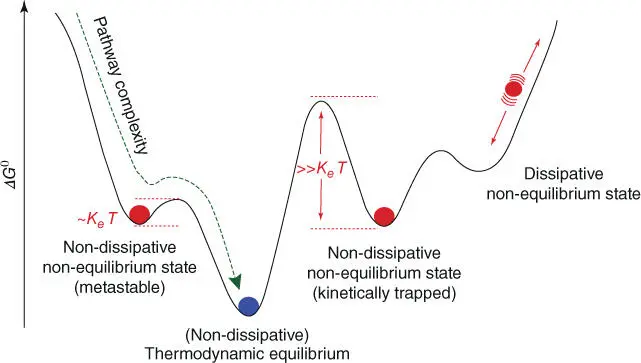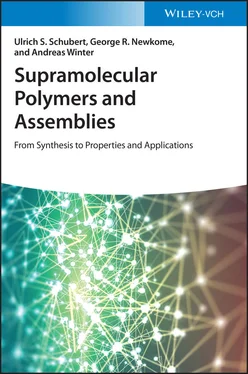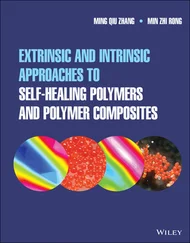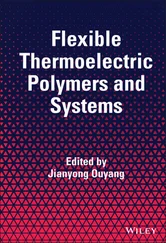
Figure 1.15 Illustration of the various thermodynamic states in supramolecular polymerizations on Gibbs free energy landscape.
Source: Sorrenti et al. [40]. Licenced under CC BY 3.0.
In polymer science, two types of materials are in the focus of research: conventional polymers and, with increasing interest, supramolecular polymers. Whereas the former ones are based on covalent bonds, the latter are formed via assembly of smaller entities by specific directional secondary interactions. Supramolecular polymers exhibit properties that are comparable to those of well‐known traditional macromolecules; however, reversibility of the secondary interaction represents an additional feature that gives rise to new applications: supramolecular polymers typically represent species in their thermodynamic equilibrium and their properties can be adjusted by applying external stimuli (e.g. changes in temperature, concentration, or solvent). Moreover, supramolecular polymers in non‐dissipative and/or nonequilibrium states also have to be considered and might be important in the future for the fine‐tuning of, e.g. shape, molecular organization, chirality, and/or dispersity of supramolecular polymers [40]. These aspects have been proposed to be crucial for utilitarian applications, as in energy conversion or biomedicine areas [148].
The broad range of supramolecular polymers that has been published so far can be classified by mainly two approaches: the type of the secondary interaction involved (as noted in the following chapters) or the mechanism by which they have been formed (in accordance with Carothers' classification from the 1930s [2]). From the three main mechanisms discussed in this chapter, particularly the isodesmic and ring‐chain‐mediated supramolecular polymerizations are now well understood; however, various effects (e.g. hysteresis and heterogeneous nucleation) make cooperative supramolecular polymerizations much more difficult to understand. Insight into the kinetics and thermodynamics of supramolecular polymers can be gained by comparing these artificial systems to the well‐documented protein aggregation. Moreover, one may compare these three mechanisms for supramolecular polymerizations to the three classes of covalent polymerization: step‐growth, chain‐growth, and ring‐opening polymerizations. For covalent polymers, the field of application often dictates the way by which mechanism the polymer may be prepared. The same also holds basically true for the supramolecular polymers.
In recent years, new concepts have evolved addressing the issue on how to control supramolecular polymerizations regarding the molecular structure and even the dispersity of the self‐assembled materials. From these, the so‐called living supramolecular polymerization represents a highly promising approach to prepare novel, designer, supramolecular materials via control over, e.g. their shape, size, and dispersity.
Going beyond a rather theoretical discussion, various types of supramolecular polymers will be introduced in the subsequent chapters – differentiated by the nature of their underlying non‐covalent/supramolecular interactions. Nonetheless, a detailed knowledge of the kinetic and thermodynamic driving forces for the formation of these materials remains a fundamental requirement.
1 1 Staudinger, H. (1920). Ber. Dtsch. Chem. Ges. 53: 1073–1085.
2 2 Carothers, W.H. (1931). Chem. Rev. 8: 353–426.
3 3 Schneider, H.‐J. and Strongin, R.M. (2009). Acc. Chem. Res. 42: 1489–1500.
4 4 Shunmugam, R., Gabriel, G.J., Aamer, K.A., and Tew, G.N. (2010). Macromol. Rapid Commun. 31: 784–793.
5 5 Wang, X.‐S., Guerin, G., Wang, H. et al. (2007). Science 317: 644–647.
6 6 Schappacher, M. and Deffieux, A. (2008). Science 319: 512–1515.
7 7 Tang, C.‐B., Lennon, E.M., Fredrickson, G.H. et al. (2008). Science 322: 429–432.
8 8 Ruokolainen, J., Mäkinen, R., Torkkeli, M. et al. (1998). Science 280: 557–560.
9 9 Pochan, D.J., Chen, Z.‐Y., Cui, H.‐G. et al. (2004). Science 306: 94–97.
10 10 Cui, H.‐G., Chen, Z.‐Y., Zhong, S. et al. (2007). Science 317: 647–650.
11 11 Cornelissen, J.J.L.M., Fischer, M., Sommerdijk, N.A.J.M., and Nolte, R.J.M. (1998). Science 280: 1427–1430.
12 12 Fréchet, J.M.J. (2002). Proc. Natl. Acad. Sci. U.S.A. 99: 4782–4787.
13 13 Kato, T., Mizoshita, N., and Kishimoto, K. (2006). Angew. Chem. Int. Ed. 45: 36–68.
14 14 Kato, T., Hirai, Y., Nakaso, S., and Moriyama, M. (2007). Chem. Soc. Rev. 36: 1857–1867.
15 15 Sivakova, S. and Rowan, S.J. (2005). Chem. Soc. Rev. 34: 9–21.
16 16 Pollino, J.M. and Weck, M. (2005). Chem. Soc. Rev. 34: 193–207.
17 17 Weck, M. (2007). Polym. Int. 56: 453–460.
18 18 Percec, V., Dulcey, A.E., Balagurusamy, V.S.K. et al. (2004). Nature 430: 764–768.
19 19 Feldman, K.E., Kade, M.J., de Greef, T.F.A. et al. (2008). Macromolecules 41: 4694–4700.
20 20 Gohy, J.‐F. (2009). Coord. Chem. Rev. 253: 2214–2225.
21 21 Lehn, J.‐M. (1988). Angew. Chem. Int. Ed. Engl. 27: 89–112.
22 22 Lehn, J.‐M. (1990). Angew. Chem. Int. Ed. Engl. 29: 1304–1319.
23 23 Lehn, J.‐M. (1993). Science 260: 1762–1763.
24 24 Lehn, J.‐M. (2002). Polym. Int. 51: 825–839.
25 25 Ciferri, A. (2005). Supramolecular Polymers. New York, NY: Taylor & Francis.
26 26 de Greef, T.F.A., Smulders, M.M.J., Wolffs, M. et al. (2009). Chem. Rev. 109: 5687–5754.
27 27 Brunsveld, L., Folmer, B.J.B., Meijer, E.W., and Sijbesma, R.P. (2001). Chem. Rev. 101: 4071–4098.
28 28 Ciferri, A. (2000). Supramolecular Polymers. New York, NY: Marcel Dekker.
29 29 Fox, J.D. and Rowan, S.J. (2009). Macromolecules 42: 6823–6835.
30 30 Binder, W.H. and Zirbs, R. (2007). Adv. Polym. Sci. 207: 1–78.
31 31 Bouteiller, L. (2007). Adv. Polym. Sci. 207: 79–112.
32 32 Rieth, S., Baddeley, C., and Badjić, J.D. (2007). Soft Matter 3: 137–154.
33 33 de Greef, T.F.A. and Meijer, E.W. (2010). Aust. J. Chem. 63: 596–598.
34 34 Hofmeier, H. and Schubert, U.S. (2005). Chem. Commun.: 2423–2432.
35 35 Hoogenboom, R., Fournier, D., and Schubert, U.S. (2007). Chem. Commun.: 155–162.
36 36 Winter, A. and Schubert, U.S. (2016). Chem. Soc. Rev. 45: 5311–5357.
37 37 Yang, L., Tan, X., Wang, Z., and Zhang, X. (2015). Chem. Rev. 115: 7196–7239.
38 38 Friese, V.A. and Kurth, D.G. (2009). Curr. Opin. Colloid Interface Sci. 14: 81–93.
39 39 Winter, A., Hager, M.D., and Schubert, U.S. (2012). Supramolecular polymers. In: Polymer Science: A Comprehensive Review, vol. 5 (eds. H.‐W. Schmidt and M. Ueda), 269–310. Amsterdam: Elsevier BV.
40 40 Sorrenti, A., Leira‐Iglesias, J., Markvoort, A.J. et al. (2017). Chem. Soc. Rev. 46: 5476–5490.
41 41 Ciferri, A. (2002). Macromol. Rapid Commun. 23: 511–529.
42 42 Odian, G.G. (2004). Principles of Polymerization, 4e. Hoboken, NJ: Wiley‐Interscience.
43 43 Zhao, D.‐H. and Moore, J.S. (2003). Org. Biomol. Chem. 1: 3471–3491.
44 44 Flory, P.J. (1953). Principles of Polymer Chemistry. Ithaca, NY: Cornell University Press.
45 45 Flory, P.J. (1946). Chem. Rev. 39: 137–197.
46 46 Ueberreier, K. and Engel, M. (1977). Makromol. Chem. 178: 2257–2260.
47 47 Chiper, M., Meier, M.A.R., Wouters, D. et al. (2008). Macromolecules 41: 2771–2777.
48 48 Knoben, W., Besseling, N.A.M., and Cohen Stuart, M.A. (2006). Macromolecules 39: 2643–2653.
49 49 Knoben, W., Besseling, N.A.M., and Cohen Stuart, M.A. (2007). J. Chem. Phys. 126, Article ID: 2409296.
Читать дальше













